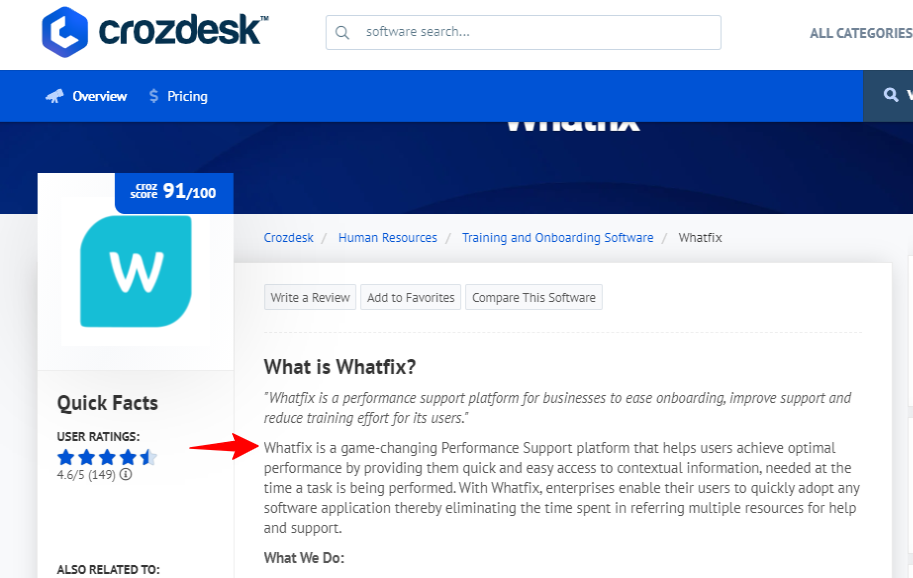Most PR teams are thrilled when their PR campaign earns coverage. However, what’s disheartening is that a majority of these fantastic pieces of PR coverage go unlinked. This is especially true when press websites such as The Guardian, CNBC, and Daily Mail mention a brand without a link.
Here’s an instance of an unlinked mention for Whatfix, the employee training software.

A sure-fire way to earn hundreds of such links is to convert unlinked PR mentions into backlinks. The tactic is commonly referred to as link reclamation.
Find unlinked PR mentions with Prowly's media monitoring
Start tracking your brand and keywords with a free, 7-day trial in Prowly.
- Comprehensive Monitoring: Track the web, social media, print, and broadcast mentions
- Transparent Pricing: Plans start at $258/month
- All-in-one platform: Get everything you need in one tool for PR, incl. media database, outreach, reporting, and more
Why should you turn unlinked PR mentions into links?
PR as an SEO strategy is tough and expensive to implement. Links are great for SEO (not brand mentions alone!). They are a cost-effective gateway to building online authority and ranking, establishing new relationships, and boosting your reputation. Hence, it’s critical for PR teams to develop a system that converts mentions into authoritative backlinks and rank better for those ultra-competitive and revenue-generating keywords.
Google is getting better at understanding natural language and values PR mentions; yet, it gives more SEO value to links. Hence, it’s important to locate mentions that have gone unlinked and convert them into high-value backlinks.
No wonder, most marketers and PR professionals are striving to convert mentions into backlinks. Check out this poll that was conducted on Twitter in 2019.
However, the purpose of a link is to add value to users, which is why it’s not always appropriate to ask for links from unlinked brand mentions.
For instance, if your brand is mentioned in a post for a study or research you conducted and there’s no link, it’s a clear opportunity to add value by linking to the complete study on your website. In this case, the link will add value to the reader as it’s an important part or extension of the article.
Unlinked brand mentions are great for visibility and PR, but turning them into backlinks makes them useful for improving your search ranking too. Here's how you can convert these unlinked mentions into high-value backlinks.
1. Find Unlinked Mentions Using Tools
Finding unlinked brand mentions isn’t a ride in the park. You can do the job without a tool; but that’ll require a lot of perseverance, time, and attention.
Each day, thousands of pages are created on the internet. Amidst the sea of online content, it’s next to impossible to find where and when your brand is mentioned. Further, you only need mentions that can represent solid linking opportunities for your business.
Hence, using the right tools can save you an unimaginable amount of time and find you relevant and fresh mentions. Tools like BrandMentions, BuzzSumo, and Semrush, among others, can help you uncover all your unlinked mentions.
Check out how a simple search for ‘The Body Shop’ on BrandMentions generates tons of results.
Google too offers businesses an opportunity to find brand mentions in all the places including social channels. All you need to do is search by keying in the following:
Intext: Brand Name -facebook.com -twitter.com -instagram.com -youtube.com -pinterest.com
For instance, if you are looking for brand mentions for ‘The Body Shop,’ you need to conduct the following search.
Intext: The Body Shop -facebook.com -twitter.com -instagram.com -youtube.com -pinterest.com
However, this search has generated more than three million results, and scanning through them to look for unlinked mentions is a lot of manual work.
That’s why it’s best to leverage the tools mentioned above to track all online mentions and relevant niche-specific keywords.
2. Find and Connect with the Mention’s Author or Journalist
Now that you have access to all your brand mentions, it’s time for action. Look for the authors or journalists who wrote the article with the mention or the publication’s corrections desk and reach out to them.
You need to determine the right person to contact. Ideally, you should contact the webmaster through the site’s ‘Contact Us’ page. You can also use LinkedIn to connect with the person, find their contact details, and reach out to them.
For a website with multiple contributors and editors, it’s best to reach out to the author of the post in which your brand is mentioned. However, make sure the person is still associated with the website.
It’s best to connect with the person first through their social profiles and then proceed with the brand association. Probably, you could start by sending them a connection request or saying a ‘Hi’ to learn more about their interests and current engagements.
In my experience, journalists seldom respond to such linking requests. That’s because they are busy content creators. In all probability, they may have moved on to another article after hitting ‘Publish’ on one. Hence, it takes a lot of effort and patience to get in touch with journalists.
The site’s corrections desk, on the other hand, exists to make amends to posts and are a good bet. You’ll find most publications offering a complete list of contacts for various purposes. Check out Glamour UK’s ‘Contact Us’ page, for instance.
3. Build a Robust Outreach Strategy
Once you have the contact details of the authors who have mentioned your brand but haven’t linked to it, it’s time to write an outreach pitch. But first, remember to ask yourself these questions:
- Why should they link to my website?
- What value will this link add to their audience?
- Will this link allow their audience to have a better experience while reading content that highlights your brand?
The answers to these questions will help you write a pitch that will help the publishing site see the value in linking to your website. Take time to craft a customized and effective outreach pitch that’ll get you mentioned links.
Here’s an example of a pitch:
Hello [First Name]!
I hope you are doing well. My name is [Your Name and Position] and I’m reaching out to you on behalf of [Organization Name]. [Add some details about your business].
I came across your article titled [Name of the Article] on the website [The Domain Name and URL That Holds the Unlinked Brand Mention].
The article is a great read! [Talk about the specific points you liked and think are adding value to the readers].
I noticed that the partnership between [Your Brand] and [Other Company] OR research by [Your Brand] was mentioned in the article. Hence, I was wondering if you could include a reference to [Your Brand]. Adding this reference will help your readers know more about the partnership/ research. [Add details on how the reference will help the readers].
Here is the URL to the [Brand Website].
I believe this reference will fit well in this section and add immense value to your readers.
Would you be open to updating this article?
Once again, I would like to thank you for mentioning [Your Brand] on your site. If you have any questions or need additional information, please feel free to get in touch.
I look forward to hearing from you!
Best,
[Your Name]
Remember not to use the word ‘link’ as it is often associated with email spam. Instead, use words and phrases like ‘references’ or ‘reference to our site.’ Also, recommend the most appropriate page to be linked while thinking of the site’s audience and UX.
4. Remember to Follow Up
Whether the link hasn’t been added or you haven’t heard from the webmaster, it’s always a good idea to follow up. But this doesn’t mean harassing them for a link.
There’s a fine line between getting after them and effectively following up with them to get your job done. So, if you email them every other day, you’ll probably land in their spam folder. Send your first follow-up email 3-5 days after sending the outreach pitch. Wait for another 10-12 days to send the next email to remind them.
If you still do not receive a response, there are chances that the email you are using isn’t being checked. Try looking for an alternative contact.
Here are a few things to bear in mind when working on a PR mention outreach:
- Remember to check the website for updates. Though not all editors or corrections desks respond to emails but may have added the link to your site. So, make sure you keep an eye on such developments.
- For influential or authoritative sites, try exploring future partnership opportunities, even if they reject your initial outreach.
- Avoid automating follow-ups. It’s best to add some personalization each time you write to them. This will help you identify opportunities and connect with a real-life person.
- Finally, if you’ve received a link, thank the webmaster/ journalist/site for referring your brand.
5. Set Up Alerts for Future Mentions
If yours is a known brand or you keep sharing innovative research, you’ll keep getting linked and unlinked brand mentions all the time. The trick is to keep an eye on these by setting up an unlinked mention alert.
Tools like Google Alerts can help you monitor any brand mention or relevant keywords. Just set an alert for your brand and the tool will keep you posted on mentions if any.
Summing Up
Converting unlinked brand mentions into backlinks is an effective SEO tactic that has stood the test of time. This seemingly simple strategy can get you valuable links and boost your ranking in the SERPs.
Use the tips shared above to earn hundreds or even thousands of new backlinks, thus improving your site’s reputation.

